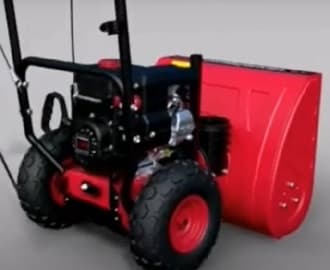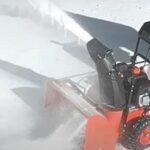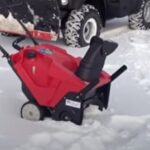As an Amazon Associate, this site earns commissions from qualifying purchases. For more information click here.
A snow blower is used mainly to clear snow off to the side, and these tools do a good job at it. But how effective is a this machine against ice? If you need to get rid of lots of ice, can a snow blower do it for you? This post is going to answer that question.
A gas powered snow blower can remove chunks of ice in snow. Just turn the snow blower on and let its augers break the ice chunks as it runs. A two or three stage snow blower however, is needed for larger, thicker ice.
What is the Best Snow Blower to Clear Ice?
There are many kinds of snow blowers, but we can divide them into three categories: single, dual and three-stage. A single stage blower has one auger to disperse snow, a dual blower has two and a three-stage blower has three augers.
A 2 or 3-stage snow blower is needed to clear ice. If you only need to clear a bit of snow, a single stage snow blower is fine. But for ice you have to get a dual or triple stage machine.
There are two options to choose from:
Gas snow blowers. These are powerful machines that can handle huge amounts of ice and snow. If you need to clear a lot of snow, we recommend the Power Smart 212cc 2-stage Snow Blower. It is designed for rugged use and can handle more ice than the typical blower.
Electric snow blowers. Electric snow blowers are affordable and easy to use. It cannot handle as much ice as a gas-powered blower and not as durable. But if you only deal with little or moderate ice, these models will do.
There are plenty of electric snow blowers, but we like the Snow Joe SJ627E because it provides a lot of power and is easy to use.
In case you’re wondering, single-stage snow blowers cannot clear ice. One auger is not enough. For a bit of snow yes, but if you have ice, get a 2 or 3-stage snow blower.
How to Remove Ice with a Snow Blower
The following steps demonstrate how a snow blower clears ice. In most cases it is a very straightforward process.
Turn the snow blower on and run it on the snowy ground. Its dual (or triple) augers will clear the ice as the blower moves. Assuming the ground only has snow and ice, you just need to keep the blower running until the ice is gone.
An ice ridge is more challenging. It depends on the size and your blower’s capacity. If the ice chunks are too large for the auger, use a shovel or another tool to break the ice into smaller pieces.
Once the ice has been reduced to smaller pieces, you can run the blower over them and let the auger do the rest.
If you are facing an ice sheet, this is more difficult. An ice sheet usually forms when a vehicle runs over an uncovered driveway numerous times. This fuses the ice as a sheet and is very hard to remove.
Can you clear up an ice sheet? Certainly a more powerful 4-cycle snow blower is needed to break up thick ice chunks. But there are other factors to consider.
With regular ice in snow, you can just run the blower over it. You can do the same with small ice ridges. If the ridge is large you just break it apart so the auger can clear it. As the machine blows snow away, ice is discarded as well.
Ice sheets are thicker though, so you need a 3-stage snow blower for it. Even then you might have to cut the ice into smaller, manageable chunks before the augers can clear them.
What Snow Blower Features Do I Look For?
The most important is the number of augers. The snow blower must have 2 or 3 augers to displace ice. A single auger machine is not sufficient. There are also other features you might want to consider.
Heated handles. Gloves can keep you warm but heated handles are even better during the freezing cold.
Variable speed. This feature comes in handy when clearing lots of snow. It also serves as a safety feature.
Lights. Snow blowing and ice removal should be done in the morning. But if you have to do it in the afternoon with the sun going down fast, headlights are a necessity.
Drift cutters These are metal bands on the auger that enable to slice through hard ice. This can be very useful for large ice ridges or sheets.
Electric starter. A lot of gas snow blowers have this feature nowadays. It is more convenient than a pull rope and simplifies operation. If you are having a hard time with the pull cord, now is a good time to switch to an electric starter.

Which Snow Blower Type is Best For Ice?
With so many options to choose from, it can be overwhelming especially if you are a first time buyer. Here are some general guidelines to keep in mind. These take into account removal of ice and snow in general.
Gas snow blowers are the most powerful. Use them to remove ice packed in snow, ridges and sheets. For large ridges and sheets, you may need to break the ice down into smaller parts first. Gas snow blowers are good for up to 2 feet deep snow.
There are different types of gas blowers, but what they all share is a large clearing capacity. This is essential when faced with heavy ice and snow. No matter what snow blower you use, take all necessary precautions.
Electric snow blowers are best suited for 12 inches or less snow. You can use it to clear small pieces of ice. But for large chunks you need a gas snow blower.
If you just need to get rid of snowy ice on paved grounds, an electric snow blower will work fine. It is more affordable, easier to use and quieter.
Battery cordless snow blowers cannot remove large amounts of ice. These are lightweight, portable and meant for small area clearing only.
Frequently Asked Questions
Can I use a single stage snow blower to remove ice?
No. These snow blowers only have one auger, which is not enough. Most have a clearing capacity of 22 inches and 6-8 inches of snow. For large ice chunks you need a 2 or 3 stage blower.
What is the difference between a 2 and 3 stage snow blower?
A two-stage blower has two augers and a three-stage has three of them. In terms of ice clearing, a three-stage blower can do a lot more. Both have a capacity of about 2 feet of snow, but three-stage blowers can handle more ice.
Can a snow blower crush ice?
It depends on the snow blower. If it is a two or three-stage type, the augers can crush small to medium sized ice. Large ice sheets and ridges are more difficult and make require you to break them down first. A first-stage snow blower cannot break ice.
Gas powered snow blowers are the best for getting rid of ice. They have the power and durability to withstand not only crushing ice but being in the freezing temperature.
Can a snow blower damage my driveway?
Yes. The augers are metal, and if they touch the surface can cause damage. This can happen if the snow is not deep enough and the blade goes through it. That is why you should only use a blower if the snow is at least 6 inches deep. Otherwise you risk damaging the surface.
How much ice can snow blowers handle?
A single stage blower has a limit of around 6-8 inches. Most two and three-stage blowers can deal with 12 inches of snow. Beyond that it gets hard especially if there is a lot of ice. Even the most powerful snow blowers can go beyond 25 inches of snow.

I love the outdoors and all the tools for maintaining gardens, yards and lawns. The only thing I am more passionate about is sharing what I know about garden and outdoor equipment.


